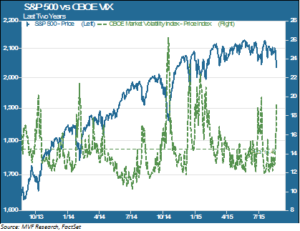
Dog days indeed. August has taken one of its characteristic twists for the worse, with a global pullback in risk assets finally encroaching on US large cap equities. On the heels of increasing instability in China, collapsing commodity markets and little to cheer about elsewhere, the S&P 500 had retreated 4.5 percent from its May high by Thursday’s closing bell. In early Friday trading the bellwether index has crashed further still to send the peak-to-trough meter past the 5 percent mark. Plenty of market pundits will be on the airwaves today reminding us of how many hundreds of days it has been since we experienced a “real” correction of 10 percent or more (another “dog days” event, in August 2011).
As investors we need to take these pullbacks seriously – but we also have to keep them in perspective. Since 1950 the S&P 500 has experienced 177 instances of a peak-to-trough reversal of 5 percent or more (where the reversal was followed by a recovery of 5 percent or more). In that time there have only been four full-on bear markets: two bookending the sluggish 1970s and then the two signal events of the 2000s: the dot-com rash and the Great Recession. The market did retreat by more than 20% in the Black Monday crash of 1987, but that turned out to be short-lived and quickly recovered. For the moment, anyway, we are inclined to see the current climate as one of those 5 percent-plus events (if indeed the market remains negative through the close) that doesn’t metastasize into something more unpleasant.
Reading the Vol
Volatility is not a perfect measure, but it is a useful tool for gauging how bad things are. The chart below plots the trend of the CBOE VIX index against the S&P 500 over the last two years.

Volatility has been fairly subdued for most of the year. Investors tend to regard a VIX level of 20 or more as indicative of significant market risk. We briefly touched that mark at the height of “Grexit” fears last month, but even that event failed to sustain volatility above its baseline level. Last October’s sharp equity reversal, with a strange flash crash in Treasury yields and a 7.5% pullback for the S&P 500, sent volatility up to levels not seen since 2011. That too, though, turned out to be a short-lived event that caught a great many quantitative hedge strategies flat-footed. Again, the message here is that volatility has crept back into US large caps, but so far there is little to suggest the onset of deeper problems.
Stressed in Shanghai
Meanwhile, asset markets on the other side of the Pacific are deep in bear territory. China’s monetary mandarins appear to be losing their grip on the domestic stock markets in Shanghai and Shenzhen, both of which have tumbled close to 10% or so in the past couple days. Manufacturing data for the first three weeks of August are at the lowest levels since the financial crisis, adding to the perception that China’s economy is in worse shape than the most recent GDP numbers indicate. As goes China, so go emerging markets. The Malaysian ringgit and Indonesian rupiah are testing the lows against the dollar reached during the 1997 currency crisis, and the Turkish lira is plumbing all-time depths. These developments only add to the general malaise that has settled over the asset class formerly known as the growth engine of the global economy.
Money Has to Go Somewhere
Our position, articulated a handful of times in recent commentaries, is that there are greater risks outside the US than within, and that equity portfolios should be aligned accordingly. We continue to be of that view. The market may be giving us a bunch of bitter lemons, but we still have to make lemonade. The problems in Asia Pacific and the Eurozone are unlikely to go away any time soon, and commodities have the characteristics of secular rather than cyclical weakness. In this environment, high quality large cap US equities continue to make a compelling case as the best of a bad lot. Indeed, the current selloff is likely to present some attractive entry points for good companies whose rich pricing has kept value investors at bay.
The key thing, however, is to go back and review the math of pullbacks: they happen with some degree of frequency, but usually do not collapse into all-out bear markets. Patience and discipline are always the best way to prevent paper losses from becoming actual losses.